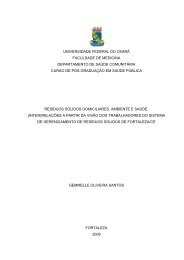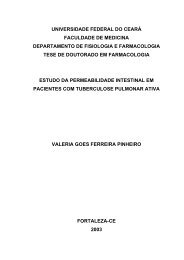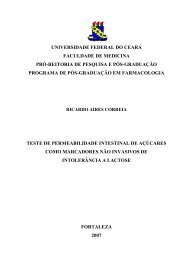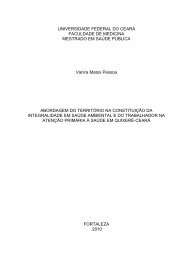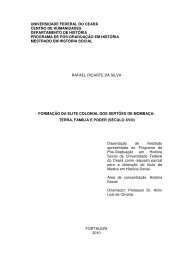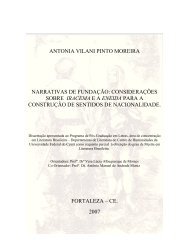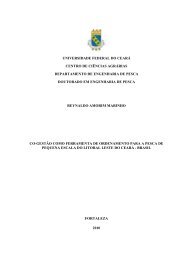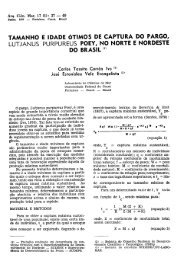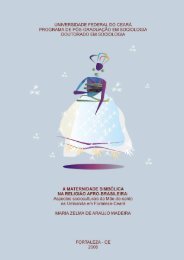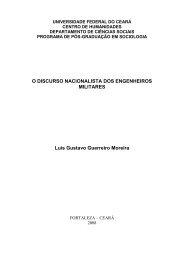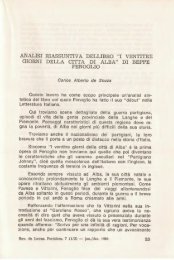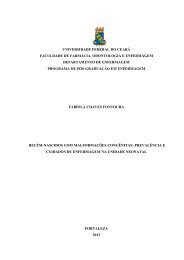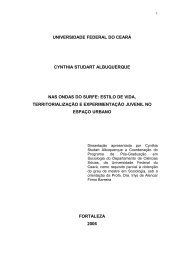dinâmica do sistema estuarino timonha / ubatuba (ceará – brasil)
dinâmica do sistema estuarino timonha / ubatuba (ceará – brasil)
dinâmica do sistema estuarino timonha / ubatuba (ceará – brasil)
Create successful ePaper yourself
Turn your PDF publications into a flip-book with our unique Google optimized e-Paper software.
ABSTRACT<br />
The Timonha / Ubatuba estuarine system is located between Ceará and Piauí States,<br />
500 km northwest of Fortaleza City, in Northeast Brazil. The hydrographic tributary basin of<br />
this estuarine system has an area of 2 165 km 2 , and lies in Paleozoic lands of the Ibiapaba<br />
Plateau, Embasamento Cristalino, Formação Barreiras and Quaternary deposits. It is<br />
important to stand out that the south portion of this estuarine basin is inserted in Pre-Cambrian<br />
lands where may be seen Granitóide Chaval exhumed inside of the system. The search for<br />
areas suitable to shrimp farming and urban/agroindustrial development may represent a<br />
potential risk to this ecosystem, which is considered the largest of the Ceará State. These<br />
impacts tend to increase with the construction and operation of the Itaúna reservoir, with a<br />
capacity of 77.5 million m 3 and located 17 km from the estuarine basin. The aim of this study<br />
was considering the structural, dynamic and controlling elements of the current state of the<br />
estuarine system, to contribute with useful information to the suitable and sustainable use of<br />
this ecosystem. The hydrodynamic and sedimentologic processes are <strong>do</strong>minated by the rainy<br />
seasons plus the sedimentation processes on the mouth by longshore current and tide<br />
oscillation. The reservoir resulted in the reduction of 91% of the Timonha river discharge<br />
presenting an outflow of 5.6 X 10 8 m 3 in a year. The regularized outflow is not enough to<br />
promote the mixing and salt dilution processes, contributing to the inversion of salinity in the<br />
drought season. In the rainy season, the salinity of Timonha River grows gradually seaward<br />
and varied from limnetic (< 0.5) to euhaline (30.0 at 40.0). In the dry season, pre<strong>do</strong>minated<br />
the euhaline pattern with strong signals of hipersalinization. In Ubatuba river, the salinity<br />
varied from polihaline (18.0 at 30.0) to euhaline between the rainy and drought periods. The<br />
estuaries are type 2a in the rainy period and 1a in the drought period. The salt balance of<br />
Timonha river in the rainy period was + 0.3 ton, while in the dry period was 0.0 ton. In<br />
Ubatuba river the salt balance was - 0.1 ton and in the dry period was - 0.2 ton. The average<br />
depth of the system is 5 m and the deeper depths were seen in Ubatuba river. The bottom is<br />
made up pre<strong>do</strong>minantly by medium sand and biogeneous sediments. The total of sediments<br />
exported to the longshore current, in a year, was 250 tons and the load imported was 150 tons.<br />
The volume of the tide prism in Timonha river was nearly 3.6 x 10 7 m 3 and in Ubatuba river<br />
4.3 x 10 7 m 3 . Considering the simplified model, the period of water residence is 1 day in the<br />
rainy period and 5 days in dry period. This period, in Ubatuba river, is 0.5 day in the rainy<br />
period and 2 days in the dry period. Considering the water residence time calculated to each<br />
segment of the channels of Timonha and Ubatuba Estuaries, it was observed that the linear<br />
model is not applicable to the system dilution capacity analysis. Based on the segmented<br />
model, it was verified, in Timonha river, that the area located between 3,7 km and 7,0 km<br />
from the sea, has a strong tendency to water retention and reaches a residence time equivalent<br />
to almost a week, been inadequate to the direct emission of effluent. Comparing to other<br />
tropical estuaries, the system presents a good dilution capacity and a low residence time. The<br />
lack of monitoring to correct the outflows released by Itaúna Dam in long dry periods and the<br />
deposition processes on the mouth river will represent the main elements to jeopardize the<br />
support capacity of the estuary.<br />
Key-words: Estuaries, Timonha river, Salt and Water Balance.<br />
8



